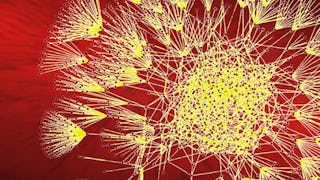This course distills for you expert knowledge and skills mastered by professionals in Health Big Data Science and Bioinformatics. You will learn exciting facts about the human body biology and chemistry, genetics, and medicine that will be intertwined with the science of Big Data and skills to harness the avalanche of data openly available at your fingertips and which we are just starting to make sense of. We’ll investigate the different steps required to master Big Data analytics on real datasets, including Next Generation Sequencing data, in a healthcare and biological context, from preparing data for analysis to completing the analysis, interpreting the results, visualizing them, and sharing the results.



(284 reviews)
Skills you'll gain
Details to know

Add to your LinkedIn profile
43 assignments
See how employees at top companies are mastering in-demand skills


Earn a career certificate
Add this credential to your LinkedIn profile, resume, or CV
Share it on social media and in your performance review

There are 6 modules in this course
After this module, you will be able to 1. Locate and download files for data analysis involving genes and medicine. 2. Open files and preprocess data using R language. 3. Write R scripts to replace missing values, normalize data, discretize data, and sample data.
What's included
11 videos2 readings6 assignments1 discussion prompt
After this module, you will be able to: 1. Locate and download files for data analysis involving genes and medicine. 2. Open files and preprocess data using R language. 3. Write R scripts to replace missing values, normalize data, discretize data, and sample data.
What's included
13 videos4 readings8 assignments1 discussion prompt2 ungraded labs
After this module, you will be able to 1. Select features from highly dimensional datasets. 2. Evaluate the performance of feature selection methods. 3. Write R scripts to select features from datasets involving gene expressions.
What's included
9 videos4 readings6 assignments1 discussion prompt2 ungraded labs
After this module, you will be able to 1. Build classification and prediction models. 2. Evaluate the performance of classification and prediction methods. 3. Write R scripts to classify and predict diseases from gene expressions.
What's included
12 videos4 readings10 assignments1 discussion prompt1 ungraded lab
After this module, you will be able to 1. List different types of gene alterations. 2. Compare and contrast methods for detecting gene mutations. 3. Compare and contrast methods for detecting methylation. 4. Compare and contrast methods for detecting copy number variations. 5. Quantify genomic alterations. 6. Connect genomic alterations to differential expression of genes. 7. Write programs in R for determining gene alterations and their relationship with gene expression.
What's included
9 videos4 readings8 assignments1 discussion prompt1 ungraded lab
After this module, you will be able to 1. Find clusters in biomedical data involving genes.2. Analyze and visualize biological pathways. 3. Write R scripts for clustering and for pathway analysis.
What's included
12 videos5 readings5 assignments1 discussion prompt1 ungraded lab
Instructor

Offered by
Explore more from Health Informatics


University of California San Diego


University of Colorado System


University of Colorado System
Why people choose Coursera for their career




Learner reviews
284 reviews
- 5 stars
55.59%
- 4 stars
27.97%
- 3 stars
8.39%
- 2 stars
2.79%
- 1 star
5.24%
Showing 3 of 284
Reviewed on Feb 16, 2023
I learned a lot, all thanks to SUNY and coursera for gradually making my dream a reality.
Reviewed on Jun 15, 2018
I feel like I wanted to have practice with the material that was covered in the lecture
Reviewed on May 19, 2019
Highly recommended! A great yet in-depth course on data science and bioinformatics.
New to Health Informatics? Start here.

Open new doors with Coursera Plus
Unlimited access to 10,000+ world-class courses, hands-on projects, and job-ready certificate programs - all included in your subscription
Advance your career with an online degree
Earn a degree from world-class universities - 100% online
Join over 3,400 global companies that choose Coursera for Business
Upskill your employees to excel in the digital economy
Frequently asked questions
Access to lectures and assignments depends on your type of enrollment. If you take a course in audit mode, you will be able to see most course materials for free. To access graded assignments and to earn a Certificate, you will need to purchase the Certificate experience, during or after your audit. If you don't see the audit option:
The course may not offer an audit option. You can try a Free Trial instead, or apply for Financial Aid.
The course may offer 'Full Course, No Certificate' instead. This option lets you see all course materials, submit required assessments, and get a final grade. This also means that you will not be able to purchase a Certificate experience.
When you purchase a Certificate you get access to all course materials, including graded assignments. Upon completing the course, your electronic Certificate will be added to your Accomplishments page - from there, you can print your Certificate or add it to your LinkedIn profile. If you only want to read and view the course content, you can audit the course for free.
You will be eligible for a full refund until two weeks after your payment date, or (for courses that have just launched) until two weeks after the first session of the course begins, whichever is later. You cannot receive a refund once you’ve earned a Course Certificate, even if you complete the course within the two-week refund period. See our full refund policy.
More questions
Financial aid available,




